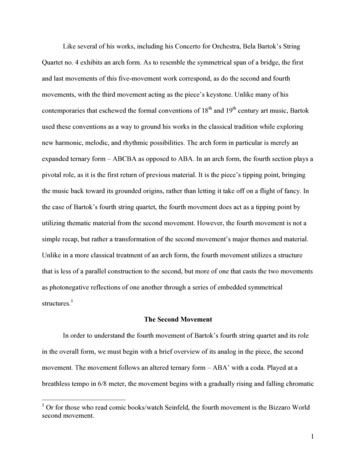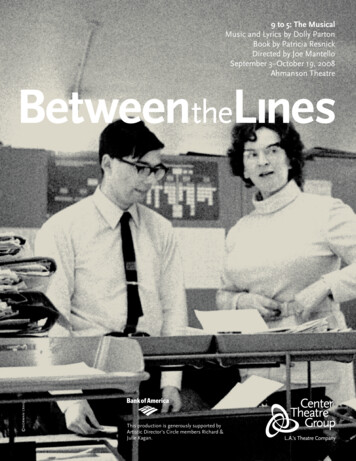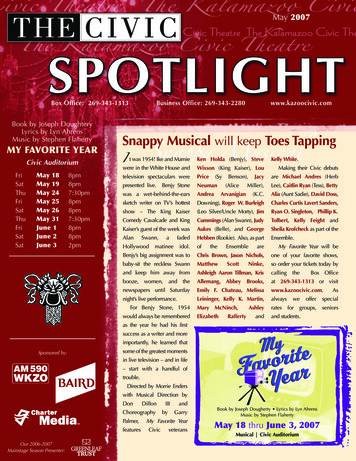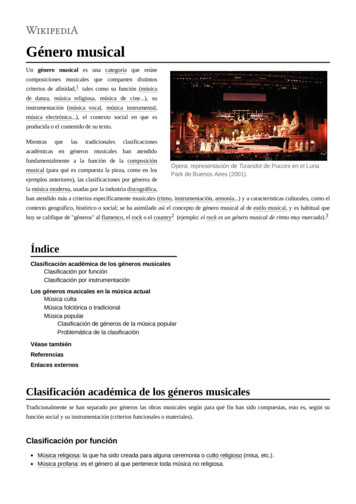
Transcription
Like several of his works, including his Concerto for Orchestra, Bela Bartok’s StringQuartet no. 4 exhibits an arch form. As to resemble the symmetrical span of a bridge, the firstand last movements of this five-movement work correspond, as do the second and fourthmovements, with the third movement acting as the piece’s keystone. Unlike many of hiscontemporaries that eschewed the formal conventions of 18th and 19th century art music, Bartokused these conventions as a way to ground his works in the classical tradition while exploringnew harmonic, melodic, and rhythmic possibilities. The arch form in particular is merely anexpanded ternary form – ABCBA as opposed to ABA. In an arch form, the fourth section plays apivotal role, as it is the first return of previous material. It is the piece’s tipping point, bringingthe music back toward its grounded origins, rather than letting it take off on a flight of fancy. Inthe case of Bartok’s fourth string quartet, the fourth movement does act as a tipping point byutilizing thematic material from the second movement. However, the fourth movement is not asimple recap, but rather a transformation of the second movement’s major themes and material.Unlike in a more classical treatment of an arch form, the fourth movement utilizes a structurethat is less of a parallel construction to the second, but more of one that casts the two movementsas photonegative reflections of one another through a series of embedded symmetricalstructures.1The Second MovementIn order to understand the fourth movement of Bartok’s fourth string quartet and its rolein the overall form, we must begin with a brief overview of its analog in the piece, the secondmovement. The movement follows an altered ternary form – ABA’ with a coda. Played at abreathless tempo in 6/8 meter, the movement begins with a gradually rising and falling chromatic1Or for those who read comic books/watch Seinfeld, the fourth movement is the Bizzaro Worldsecond movement.1
theme (A-a, fig. 1) in the viola and cello. Bartok treats the theme in a fugal manner, bringing in aFigure 1second iteration of the theme in the violins at m. 10 a perfect fifth higher than the first. A secondsub-theme (A-b) enters at m. 20 – a diatonic alteration of the original statement. Over the next 34measures, Bartok liquidates the theme into smaller fragments, in addition to introducing a motivethat circles a given note and then gets stuck on it (fig 2).Figure 2The original chromatic theme returns at m. 54 (A-a’) entering this time in close stretto and inoctaves rather than fifths, eventually liquidating and transitioning to the larger B section in themiddle of m. 75.The B section introduces a newcomposite theme in the violins – asort of cambiata figure that circles aFigure 3given note (B-a fig. 3),foreshadowed by the “stuck”2
motive (fig. 2). The cambiata figure eventually gets subsumed into the clustered accompanimentfigures at m. 102, introducing a new, rather tune-less, section. (B-b). This figure is eventuallyinterrupted by a series of glissandos at m. 137, which is in turn developed into a series of risingand falling runs that utilize both diatonic and octatonic scales through m. 175 (B-c). At measure175, fragments of the original theme from A return, beginning a retransition (B-d) thatculminates with the return of the full A-a theme at m. 189. Curiously, this is not a traditional fullrecapitulation, as the first sub-theme (A-b from m. 20) fails to return. Bartok continually subvertsthe classic ternary model from here on out, suggesting a false coda at 213, utilizing materialreminiscent of the cambiata figure (fig. 3). However, the material of this coda is furthersubverted, revealing a true coda at 223 built on diatonic liquidations of the of the movement’soriginal (A-a) theme.Moving to the Fourth Movement – The A themeWith the basic form and thematic ideas of the second movement established, we can turnour attention to the fourth movement. At first glance, the relationship between the two seemstenuous at best. In terms of timbre, tempo, and meter, the movements have strong contrasts. Thebreathless tempo of the second (176-196 bpm) is dialed down to a statelier allegro (142 bpm).The 6/8 meter is transformed into 3/4. The mellifluous muted sounds are replaced by harshpizzicatos. However, upon closer inspection, the strong, symmetrical relationship between thetwo movements becomes clear, right from the very beginning.To start, let us look at the opening theme of the fourth movement (fig. 4) and compare itto the opening theme of the second. When observed in tandem, it is easy to see the similarity interms of contour. Both themes move up and down by step, making smaller and smaller arches as3
they progress. But when the melodies are reduced to just their pitch content (with repeated notesomitted, fig 5), the similarities become even more striking. For the first two rising and fallingFigure 4phrases within the themes, the contours line up completely, as if they are the same melody. Themelodies ascend for seven notes then descend for five; then ascend for four notes and finallydescend for five more. In this way, the theme of the fourth movement becomes a direct diatonictransformation of the second movement’s chromatic theme.Figure 5The fourth movement theme is not a perfect analog, however. If that were the case, we couldmap each pitch class of the second movement theme to exactly one pitch class of the fourthmovement theme, which is not the case here (see the third vertical line in fig 5).The link between these two opening themes is more than just an analogous contour.Despite the fact that the melodies use two distinctly different scales (chromatic and diatonic),they share an underlying sound through the emphasis of whole-tone pitch sets. In the second4
movement A-a theme, the metrically-strong notes in the melody (F,G,A,B) form a four-notewhole tone scale within the chromatic sound world. In the fourth movement A-a theme, Bartokdoes not use a typical diatonic scale, but rather a major scale with raised 4th and lowered 7thscale degrees. This scale occurs tonally as the fourth mode of the ascending melodic minor scale,and is usually referred to as the “Lydian dominant” scale in a jazz context. However, in hisgroundbreaking work on Bartok’s music, theorist Ernö Lendvaï refers to the scale as the“acoustic scale,” as the notes roughly correspond to the 8th through 14th notes of the harmonicseries.2 Bartok’s affinity for this scale is not necessarily because of his interest in creatingsonorities based on the harmonic series, but because the scale contains sets that also belong totwo scales of limited transposition that appear through much of his work – the whole tone scaleand octatonic scale. In the acoustic scale, there are five consecutive notes separated by wholesteps from the 7th through 4th scale degrees. In addition, one can find an octatonic set (alternatingwhole and half steps) from the third through first steps in the scale (figure 6).Figure 6In the A theme of the fourth movement in particular, Bartok emphasizes the whole-tone qualityof the scale through the extensive use of downward major third leaps at the end of the theme (thelast bit of theme that stays with the listener), the only kind of third that occurs in a whole tone2Ernő Lendvaï, Béla Bartók: An Analysis of his Music, introd. by Alan Bush, London: Kahn &Averill, 1971, p. 27.5
scale. Thus in both the chromatic second movement A-a theme and the diatonic fourthmovement A-a theme, Bartok manipulates the pitch material to emphasize a whole tone scale,thus creating a subtle shared harmonic world for the two movements.In addition to similarities of contour and underlying pitch emphasis, the themes are bothtreated in a fugal manner, with successive instances of the theme entering a perfect fifth abovethe previous instance. In the second movement, the viola and cello enter with the theme inoctaves, starting on E. The violins then enter at m. 10 in octaves on B. The fourth movementbuilds on this fugal relationship, introducing four instances of the theme rather than just two –Bartok first presents the theme on Ab in the viola, then Eb in the 2nd violin, then Bb in the cello,and finally F in the first violin.After the violin finishes its iteration of the fourth movement A-a theme, Bartok begins toliquidate the material, as he did in a similar place in the second movement. In m. 37, Bartokintroduces rising and falling thematic fragments in close stretto (one beat separation) at theoctave in pairs – the high strings and lower strings paired off. This thematic developmentexhibits a close link between m. 37 in the fourth movement and m. 54 (A-a’) of the secondmovement. In this way, while the form of the second movement A section is aba’, the form ofthe fourth movement A section is only aa’, the same form as second movement recap. Thisrelationship creates a palindromic form rather than a parallel one, suggesting the movements assymmetric reflections of one another, an idea strengthened by the use of the acoustic scale,which has symmetric whole tone and octatonic sections embedded within it. As we will see laterin the essay, this palindromic relationship is confirmed by the relationship between the first Asection of the second movement and the A’ section in the fourth movement.6
This symmetric relationship also helps clarify the peculiar facets of the second movementA section. The A-b theme that enters at m. 20 and the ensuing instances of the “stuck motive”never return explicitly in the movement. However, much as the stuck motive foreshadows thefirst theme of the larger B section (the cambiata), the short diatonic projection of the A-a theme(A-b) now appears as a foreshadowing of the diatonic treatment of the A-a theme in movementfour. In this way, the second movement A-b theme and stuck motive are invasions of the secondmovement exposition by other sections of the piece. While these invasions obscure the form ofthis section, they also act as glue, holding movements two and four together for the listener.The B Section – First ThemesAt measure 45 in the fourth movement, the liquidating A section theme (A-a’) issuddenly halted by a series of strummed cluster chords in the viola and cello. The startlingchange in the accompaniment syntax shows that m. 45 marks the beginning of a new largesection, B. In the pickup to measure 47, the next major theme (B-a) enters in the second violinfollowed closely by another entrance in the first violin – a clear variation on the on the cambiata(B-a) theme (fig. 3) from the second movement. At measure 65, these cambiata themes arereplaced by a single chromatic texture, a clear analog to the second subsection of the secondmovement’s B section (B-b). Thus on the syntactical surface, the B section of the fourthmovement follows a parallel form to the B section of the second movement.However, just as the A section of the fourth movement uses different-yet-related pitchmaterial from the concurring section of the second movement, the B section of the fourthmovement also transforms the pitch material from the second. First, we will look at how pitch isutilized differently in the first themes of respective B sections. In the second movement, thecambiata motive in the two violins ascends gradually from m. 78 through m. 85. Over this span,7
the main notes of the figure (the long, held notes) form a whole tone set from Eb up to A (fig 7).After holding at the top of this set from m. 85 through m. 89, the motive descends through thewhole tone set again, this time moving all the way down to C# in m. 95. After a pair of glissandi,the motive ascends again, this time outlining a diatonic set – E, G, A, and B. So while the firsttheme of the second movement’s B section is chromatic when looked at motivicly, it is treated ina way that suggests both whole tone and diatonic sound worlds.Figure 7In the respective A sections of the second and fourth movements, we found that the pitchcontent of the fourth movement A theme was altered in a way to illuminate a different characterof the second movement A theme – the use of the whole-tone heavy acoustic scale in the fourthmovement helped bring out the embedded whole-tone pitch set within the second movementtheme. In the fourth movement B-a theme, a somewhat similar process occurs. When we look atthe main notes of the cambiata B-a theme in fourth movement, they form a much smaller pitchset than the corresponding section in the second movement – the set F, G, Bb and C (fig 8). TheFigure 8sonic quality of this pitch set is rather ambiguous. It can belong to a host of diatonic scales, bothmajor and minor, as well as a pentatonic scale. This particular pitch set does not set up a8
definitive harmonic soundworld for the fourth movement B-a section in the same way that theembedded whole tone scales do for the second movement B-a section. Since the pitch material ofthe theme itself does not suggest a particular harmonic center, we must look at the thematic notesin tandem with the notes of the accompaniment to find one.At the start of the B section in m. 45, the viola and cello play a series of strummed chordsthat form to make a complete chromatic cluster from A to D. Over this cluster, the two violinsplay notes that combine to form a complete chromatic cluster from E through Ab. When youcombine these two clusters together, you get a nearly chromatic complement, minus Eb. Thischromatic organization of pitch is continued in the next phrase, beginning in the middle of m. 55.The accompanimental voices create a chromatic cluster from D to G, while the melodic voicescreate a chromatic cluster from A to Db, thus combining to form a near chromatic complementagain, this time minus Ab. The Ab is continually avoided until the last beat of m. 63, ushering inthe cadential material of the next two measures. So while the cambiata theme emphasizeddiatonic and whole-tone qualities in the second movement, it becomes a photonegative reflectionof itself in the fourth movement by emphasizing chromatic qualities instead.The particular notes that Bartok leaves out of his chromatic pitch sets in this sectionshows how he reimagines the harmonic relationship between the A and B sections of classicternerary form. In a classic ternerary form, the key of the B section is generally the dominant ofthe A section’s key. Instead of seeing this convention as a strict rule to be followed, Bartok seesthe move from I to V as a way to refresh the pitch content of a piece. In the fourth movement ofthe fourth string quartet, the A section begins with a sort of Ab tonic (as the first note of theacoustic scale) that grounds each successive fugal instance of the A-a theme. In the final A-a’theme of the section (m. 37), the two pairs of liquidating thematic material emphasize Ab (the9
upper strings) and Eb (the lower strings). Because of this particular emphasis on these mainnotes, Bartok decided to leave them out in the beginning of the B section in order to create asense of pitch refreshment without having to use a strict tonal system.The B Section – The clusters take overAt m. 65 of the fourth movement after a brief pause, all four instruments enter to create asingle chromatic cluster texture, just as in the second movement at m. 102. In terms of pitchcontent, these B-b sections are almost identical. The second movement version utilizes achromatic pitch cluster from Ab-Eb, while the fourth movement version utilizes one from A-E.While these sections begin almost identically, they quickly break off and seemingly followdivergent paths. The second movement B section introduces two other sub-sections (b’ at m. 113and c – the glissandos/runs – at m. 136) before moving to the retransition. The fourth movementB section appears to move right to the retransition from the B-b theme without any additionalthematic material. Does this mean that the reflective relationship between the two movementsbreaks down at this point?If we look closely at the B-b theme of the fourth movement, there is one particular aspectthat differentiates it from the analogous section in the second movement. In the secondmovement, this theme is extremely connected. Even when instruments enter and exit, they do sowithout interrupting the diaphanous texture. In the fourth movement, the theme containsnumerous accented interruptions that eventually coalesce into cadential material in m. 76. Theseloud interruptions do not appear out of nowhere. In fact, they are an important characteristic ofthe B-c thematic material from the second movement (see m. 147, 151, 165-68). Because of thisfact, we can see the B-b theme of the fourth movement as a condensation of the B-b and B-cthemes of the second movement. It is as if in the development process from negative to10
photograph, a part of the photograph got smudged, creating one object where there hadpreviously been two. Because of this condensation of thematic material, the reflectiverelationship of the second and fourth movements holds through the B section.From Retransition to RecapAt first glance, the transitions from the B section to the A’ sections from the second andfourth movements are closely related by how they utilize melodic fragments from the A-athemes. In the second movement at m. 175, the second violin plays short falling chromaticgestures while the viola responds with short rising chromatic gestures. It is as if the A-a themehas been chopped up and divided between the two instruments. This gesture acts as a classicretransition, clearly setting up the return of A material by prolonging a particular harmonicgesture. However in the fourth movement at m. 78, the second violin and cello play a rising andfalling gesture that appears like the first two measures of the A-a theme, before being interruptedby sul ponticello accents that are reminiscent of the interruptive accents from the B-a theme. Thisprocess repeats from m. 80 through 83, and is followed by a phrase from m. 85 through 87distilled from the descending major third motive utilized in the A-a theme. The transition to thefourth movement recap is thus more similar to a classical development than a retransition in howit juxtaposes important elements of both themes. This peculiar gesture continues to emphasizeBartok’s process of using classical forms as a starting point, then consciously subverting them tocreate a novel, yet grounded form.In the fourth movement, the recap begins with what at first appears as a full restatementof the A-a theme. Looking at the melody in the first violin, the contour of the A-a theme returns,as does the acoustic scale starting on the “tonic” of Ab. However, this recapitulation does notresemble the opening A theme as first presented. At the beginning of the piece, the theme is11
presented in full before a second instance is presented a perfect fifth above. Here, the themepresentation in the violin is followed one beat later by a presentation in the cello at the octave.Rather than resembling the opening A-a theme (fig. 4), this recap resembles the A-a’ theme ofthe movement, first presented at m. 37. Once again, this curious treatment of thematic materialsuggests a different relationship between the second and fourth movement rather than mereparallelism. However, this relationship must be defined by what follows this return of the A-a’theme.From m. 88 through 101, the relationship between the two melodic voices – violin I andcello – remains the same, with the cello following the violin in strict imitation at the octave. Atm. 102, the violin II and viola become the melodic instruments, working in a similar relationshipto the violin I and cello – the violin follows the viola a beat later in strict imitation at the octave.However, the sound of the thematic material in this section contrasts sharply with what camebefore. Instead of continuing to use the acoustic scale, this statement of theme utilizes a moretypical diatonic scale, specifically the Db major scale (except for one d natural in the viola in m.105). In addition, while all of the previous presentations of the theme began with an ascentfollowed by descent, this presentation begins with a descent followed an ascent, suggesting somesort of inversion. As shown below in figure 9, this presentation of theme most closely resemblesa retrograde inversion.12
The large opening contour followed by smaller contours is replaced by a smaller contourfollowed by a larger one.So if the first sub-section of the fourth movement recap is a return of the a’ theme, whatshould we call this diatonic, retrograde-inversion presentation of the movement’s main theme? Iwould argue that this sub-section can be described as the missing A-b theme from the fourthmovement’s opening section. Remember in the second movement A section, we had a thematicform of aba’, where the b theme was the diatonic projection of the chromatic a theme. In thefourth movement, the form of the opening section was just aa’, resembling the form of thesecond movement’s recap. Just as the second movement’s b theme was a diatonic projection ofthe a theme, the fourth movement’s major diatonic projection of the acoustic-scale-centeredtheme can be seen as another photonegative reflection of an event in the second movement.There is no other direct analog of this gesture within either movement.If we take this subsection of the fourth movement recap to be notated as b, then the formof the recap thus far is a’b. Looking back to the second movement, this form appears to be aretrograde, or rather a mirror image, of the second movement’s A section. However, at measure112, where one would expect the a theme to finally reappear, we find a new theme, a simplediatonic descent from C to Ab that is continually repeated. Without a true analog to this gesturein either the second or fourth movements, it is clear that this theme introduces the fourthmovement’s coda. So instead of creating a true palindromic reflection of the second movement’sA section in the fourth movement’s recap, Bartok halts the process before completion. Just asdeveloping a photograph from its negative can yield inconsistencies from the source material, sodoes the fourth movement contain formal inconsistencies that cannot be neatly explained by thisphotonegative relationship with the second movement.13
Overall though, it is clear to see that these reflective structures are at play throughout theentire piece on different architectonic levels. At the highest formal level (excluding the codas),the second and fourth movements appear as mirror images:2nd movement4th movementA B A’ A’ B AAt the next highest architectonic level, the “A” sections in both movements also appear as mirrorimages:2nd movement A section (m. 1-75)4th movement A section (m. 88-112)a b a’ a’ b (process interrupted by coda)Even at the much lower architectonic levels such as pitch use, there are suggestions of symmetryand photonegative reflection, such as the use of the acoustic scale (that includes subsets thatbelong to the symmetrical whole-tone and octatonic scales) and emphasizing both chromatic andwhole-tone aspects of the same theme in analogous sections, as if one scale were black in thenegative and white in the actual photograph (and vise versa).A Coda for the CodasLike the piece as a whole, the codas of the second and fourth movements do not seem tohave much in common at first glance. Their thematic materials seem only tangentially related tothe rest of their own respective movements, much less each other. However, despite the surfacedifferences, the codas of the second and fourth movements play much the same role and use thesame basic processes. Notably, both movements end quietly, and the codas act as a means ofletting the air out of the balloon so to speak. They achieve this through dynamic changescertainly, but also through how they distil and condense the material of the entire movement intoelemental forms. The second movement coda, beginning at m. 223, utilizes almost all of the14
movement’s major gestures at some point, including short diatonic descending figures (A-b),chromatic figures that circle a note (B-a), thin static textures (B-b) glissandi (B-c), and quietheld-out notes (B-b’). The coda thus completes a process of disintegration, continually recyclingthe material until there is nothing left to recycle.While the fourth movement coda is not as densely packed as its second movementcounterpart, it too completes the movement’s disintegration in an efficient manner. Over thecourse of the section, beginning on beat 2 of m. 112, a descending motive of three whole stepseventually resolves to a motive of a whole step plus major third, the whole motive outlining atritone (fig 10).This first motive is an elemental condensation of the A-a theme – a motive as small as one canmake that retains the whole-tone character of the original theme. But the resolution to the nextmotive presents a curious problem: to tonally-trained ears, this second motive is more dissonantthan the first, as it outlines a tritone.Why would Bartok move from resolution to tension to end a piece? Just as throughout therest of the movement, Bartok is attempting to reverse the expectation of how a piece of musicfrom the classical tradition should work. Instead of resting on a point of sonic consonance,Bartok instead wishes to rest on a point that codifies the deep symmetrical structures of themovement. This particular combination of intervals – a major second and major third – naturallyoccurs three times in the acoustic scale: scale degrees 1, 3, and 4; 4, 7, and 1; and 7, 2, and 3.This combination also does not naturally occur in the common diatonic major and minor scales.15
By ending in this way, Bartok is trying to orient our ears away from hackneyed, Germanic tonalresolutions and point it toward mathematically ideal resolutions instead. This curious resolutionsums up the form of the fourth movement of the string quartet and its photonegative relationshipto the second movement. Bartok argues that the tonal system as practiced in his day is a falserepresentation of true mathematical beauty and attempts to reflect this system back on itself toreveal a pure musical expression.16
BibliographyLendvaï, Ernő Béla Bartók: An Analysis of his Music. introd. by Alan Bush. London: Kahn &Averill (1971).17
theme (A-a, fig. 1) in the viola and cello. Bartok treats the theme in a fugal manner, bringing in a Figure 1 second iteration of the theme in the violins at m. 10 a perfect fifth higher than the first. A second sub-theme (A-b) enters at m. 20 - a diatonic alteration of the original statement. Over the next 34











